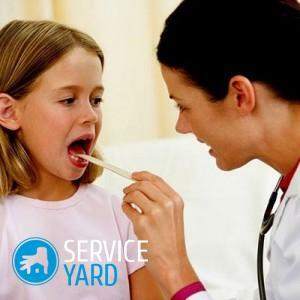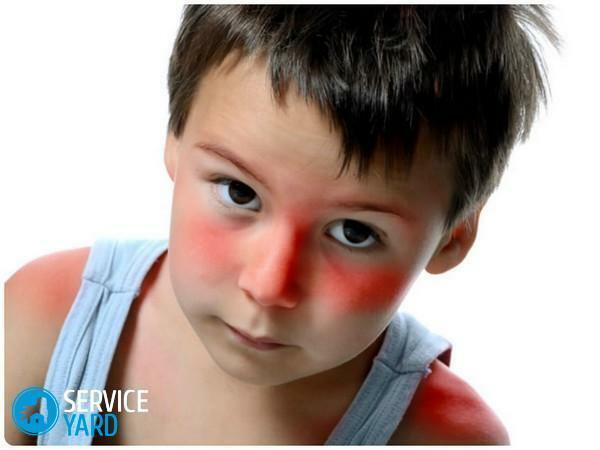
- Dermatological manifestations
- Red spots due to skin problems
- Allergic reactions
- Red spots due to illness
- Consequences of insect bites
- What if there are red spots?
With the eruptions on the body, the child encounters almost every parent. They can appear for a variety of reasons, and look completely different. The most common red spots in the child, arising not only on the body, but also on the face. Most often, the appearance of foreign reactions on the skin is associated with diseases, but this is not always so, because the child's organism reacts very sharply to all external factors - food, clothes, insect bites and even air in the room. In addition, red spots can be completely natural and depend only on heredity. Consider the most common causes of rashes in the baby.
to content ↑Dermatological manifestations of
There are several types of red spots that do not depend on diseases and infections. Often they remain for life and do not cause trouble. However, you need to consult a pediatrician if you find even a slight redness in your opinion.
Pigmented spots
These are spots that appear due to genetics, as well as a malfunction of the skin cells. Most often they remain for life, but can also get off the skin with time. The pigmentary red spots in the child may be regular round or irregular in shape. If the body formed a large amount of pigmentation, then do not delay the trip to the doctor.
Red birthmarks
Often they occur in toddlers in the face area - on the forehead, wings of the nose, the back of the neck or lips. Appear such marks due to the expansion of capillaries at the time of the birth of the child. There is a regularity that symmetrical spots disappear from the skin during the first year of life, but solitary ones can remain forever.
Hemangiomas
These are specific specks that protrude slightly above the surface of the skin. They are formed from small blood vessels located very close to each other. Often they are mistaken for the birthmarks of the child's red spots, but the hemangiomas have a significant difference - they do not grow with the body.
As a rule, in the first few months of life the stain increases or does not change in size, and subsequently begins to disappear. Usually such spots are completely harmless, but if there is inflammation, the hemangioma will have to be removed surgically or cryotherapy.
to content ↑Red spots due to skin problems
There are a number of reasons that can trigger the appearance of red spots on the skin of a child. It is best to name the reason or choose the correct treatment can only a pediatrician or dermatologist, so even if you know what caused the rashes, it is worth consulting with a specialist.
Furrier
Furrows are perhaps the most common problem that parents of infants face. They are specific redness next to the anus, on the pope, in the groin or between the buttocks. Most of the diaper rash appears due to improper hygiene of the baby. So, moisture and friction are the most common causes of this problem.
In order to avoid diaper rash, it is necessary to change the diaper at least every 3-4 hours. In addition, after washing, you must carefully dry the baby and allow him to stay without clothes for about 10 minutes. If there are still slight redness, then you should use a baby cream or powder.
Contact( diaper) dermatitis
A similar problem is most common on the pope, genitals and hips of girls and allergic children. First, there are red spots on the skin of the child, from which small pimples with a liquid of white color are then formed. The main reason for this problem is the reaction to a diaper or a detergent that was washed with diapers or sliders. After changing the powder, as well as stopping the use of diapers, contact dermatitis often disappears.
Sweating
Sweating is a small small rash on the folds of the skin, especially in the area of the back, shoulders, priests and genitals. The main cause of this problem - high humidity and high air temperature in the room, too warm clothes. The thing is that the child's sweat system is adjusted up to two years, so the regulation of sweating is disrupted.
In case of sweating it is more often to rinse the child, while drying it well, in addition it is desirable to put on only natural cotton clothes. A cream with zinc oxide will help soothe the skin, remove itching and irritation.
Fungal infections
When contacting the skin of a child with harmful microorganisms and fungi, there are often specific symptoms. Thus, fungal spots have a red color, fringed and uneven edges, ulcers and small sores are formed. Often red rashes are strongly itchy and cause a lot of inconvenience. In addition, the fungus is very contagious, so you should be careful when you contact the baby.
Treatment of the fungus is very simple, but requires systematic, because there may be a relapse. Therapy is always complex - an antifungal ointment, the intake of vitamins and drugs to enhance immunity.
Pink lichen
This is one of the forms of fungal infections. Infection occurs due to contact with a sick person or animal. Often the cause of deprivation is a visit to the public pool and the beach. Pink lichen appears in places where increased sweating - in the folds of the skin, underarms and in the groin in the form of asymmetric red spots with uneven edges.
As a rule, the illness in a child is accompanied by an increase in body temperature and an increase in lymph nodes. Only a pediatrician can choose the right treatment to completely remove the fungus and avoid relapse.
to content ↑Allergic reactions
If the child is covered with red spots, then the allergy is the most common cause of this phenomenon. The baby's organism is sensitive to food, the environment and even clothes, so you should be careful when including new products in the baby's menu, as well as when it comes into contact with household chemicals and new items. There are several forms of allergy manifestation.
Allergic diathesis
Doctors are inclined to believe that this is not yet a real form of allergy, but only a predisposition to it. As a rule, it occurs in a child in 3 months, and children with excess weight are most prone to this problem. Red cheeks, rashes, accompanied by severe itching behind the ears, neck and legs - the most vivid symptoms of diathesis.
When breastfeeding during diathesis, the mother should sit on a restrictive diet, eliminating cow's milk, fish, honey and citrus fruits. 
Urticaria
It is a small red rash all over the body. The spots are strongly itchy and cause a lot of discomfort to the child. Often, hives occur as a reaction to unusual foods, medicines, and synthetic clothing. An antihistamine ointment prescribed by a doctor has a rather quick effect if the treatment was prescribed on time.
Allergy
Allergic spots are hard to miss. They appear concentrated throughout the body in the form of a red or pink rash. The problem can arise because of the use of allergenic products - eggs, honey, fruits, sweets, cow's milk. In addition, contact with household chemicals and interaction with new toys, clothes and bed linens can also cause an allergic rash.
If you notice red spots in a child, then it is worth to pass a test for the allergen and exclude this product or thing from use. In addition, antihistamines always have a very fast effect, if the remedy was chosen correctly.
to content ↑Red spots due to
disease Rashes in red are a symptom of a huge number of diseases. Especially they suffer from children who have just gone to kindergarten, because even a single pupil can cause infection in the whole group. However, if a child has recovered from the disease for the first time, there is a great chance of the appearance of lifelong immunity to her pathogen. Here are the most frequent infectious causes of red spots.
Measles
This is a common infectious disease that manifests itself one week after contact with an infected person. However, the rash on the body does not appear right away - in the first few days a high fever is maintained, accompanied by a cough, runny nose, eyelid puffiness and photophobia. It is because of this that measles are often treated as an ordinary respiratory disease.
Approximately on day 5, a small pink or red rash appears throughout the body, the spots of which have an irregular shape and gradually merge into large spots. Eruptions always spread from above - first in the ears, then on the face, neck and body. The rash on the legs appears in the last turn. As a rule, drug treatment helps very quickly, if it was prescribed at the beginning of the illness. In addition, immunity to measles is developed for life.
Rubella
Rubella is an infection that is known for its infectiousness. It is transmitted by airborne droplets and quickly penetrates into the body. The child may already be infected for up to a week before the appearance of red spots.
The disease causes red spots on the skin of the child, and the largest accumulation of rashes are seen on the face, back and chest, sometimes in the mouth. In children, as a rule, there are no other symptoms. Spots very quickly come off with medical treatment, and rubella is best at a young age - it is at this time that it flows most easily. As in the case of measles, immunity to the disease remains for life.
Scarlet fever
This is an infectious disease caused by the ingestion of streptococcal microorganisms into the human body. As a rule, there is a high fever and severe pain in the throat. A few days later, a typical small rash appears all over the body, especially in the armpits, groin and skin folds, which itches very much.
A distinctive feature of scarlet fever is the absence of red spots in the area of the nasolabial triangle. With the correct drug treatment, all symptoms are already after five days, and the body develops immunity to the pathogen.
Chicken pox
Chickenpox is one of the most common infectious diseases in childhood. It is transmitted by contact with an infected person or by airborne droplets. A few days after the infection with chickenpox, a small red rash appears throughout the body, accompanied by severe itching. Over time, the spots change to blisters, and then completely disappear. The chickenpox is very individual. In some cases, there is a strong temperature and weakness, but sometimes the disease can occur without any side effects. In childhood, chickenpox passes much more easily and develops resistance to the causative agent of the disease.
Erythema
Infection of erythema chamera occurs always by airborne droplets. From the first days there are red spots on the skin of the child, which merge and form one large spot. Often, redness begins with the face, and then descends to the rest of the body surface. Within two weeks with proper treatment, the spots turn pale, then completely go off the skin.
Roseola baby
The causative agent of this disease is herpes simplex type 6.The disease can be transmitted both in contact with the infected person and from mother to child. At first, there is a strong fever and fever, and a few days later a rash appears all over the body in the form of red spots of different sizes. Rashes do not bring inconveniences - there is no itching and burning. Even without medicines, roseola passes a week after infection.
Molluscum contagiosum
This is a viral disease that often occurs in infancy. It manifests itself in the form of swollen spots of red color. To the touch, they are quite dense, and in size there is not more than a pea. Initially, there is only one nodule, but after a few days they spread throughout the body. The worse the immunity of the child, the more nodules will be throughout the body. The spots do not itch and do not hurt at touch, in addition, the molluscum contagiosum passes a week later even without medical treatment.
to content ↑Consequences of insect bites
The baby's body is very sensitive to the toxic substances of insects. Therefore, often there are red spots and points after their bites. As a rule, there is no rash, and the spots are located in completely different places. But burning and severe itching is almost always observed.
The worst situation is with bee stings and wasps. So, if the stinger remains in the skin, then there is a small abscess, redness and swelling. In such a case, it is necessary to remove the insect sting and treat the bite with a special remedy.
to the contents ↑What if there are red spots?
If you find numerous red spots on the skin of a child, then you should not self-medicate. Only a pediatrician can make the correct diagnosis after visual examination and delivery of tests. Sometimes even dangerous diseases - meningitis and hepatitis at the initial stages can provoke the appearance of red spots, so do not delay the visit to the doctor.
As you can see, the red spots in the baby on the skin can be the result of a variety of causes and diseases - both minor and easily cured without special drugs, and very difficult. Therefore, when such signs appear, one should not panic, but also ignore the help of competent specialists, too. In a timely and reasonable manner, respond to various ailments of your child and then he will grow up a healthy and joyful baby, delivering you many pleasant minutes.


